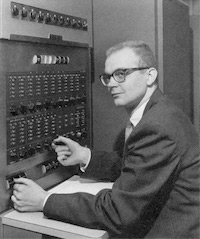The Dawn of Programming and Language Foundations (1959-1962)
The late 1950s and early 1960s represent a foundational era for computer science, as indicated by titles focused on the very essence of making computers work. Key themes revolve around the emergence of programming concepts, the nascent quest for efficient computation, and the crucial role of new programming languages. We see efforts to enable "Algebraic Translation on a Limited Computer" (1959), highlighting the immediate challenge of getting machines to understand human-readable instructions under significant hardware constraints. Theoretical underpinnings were also explored, such as "An Imaginary Number System" (1960), suggesting an early interest in the mathematical and abstract aspects of computation.
The early 1960s saw a clear emphasis on the development and formalization of programming languages. The titles "SMALGOL-61" and "ALGOL 60 confidential" (both 1961) underscore the significance of ALGOL as a leading language of the time, with a hint of its internal discussions or complexities. By 1962, the focus shifted slightly to practical application and formal description, as seen in "Evaluation of polynomials by computer" and "The calculation of Easter," demonstrating how these new computational tools were applied to solve specific, real-world problems. Concurrently, "Backus' language" points to the critical work on formalizing language syntax, setting the stage for more robust and well-defined programming. This period establishes the initial drive to create, understand, and apply the basic building blocks of computer programming.
Refining and Standardizing Programming Practices (1963-1967)
Moving into the mid-1960s, the field demonstrates a notable shift from simply making programs work to optimizing their performance, formalizing their structure, and addressing emerging complexities. There's a clear continuity in the focus on practical problem-solving, but now with an added layer of sophistication. For instance, titles like "Length of strings for a merge sort" and "Letters to the editor: three letters on merging" (both 1963) indicate a deeper dive into algorithmic efficiency and the practical challenges of data manipulation, moving beyond just basic arithmetic. The concurrent emergence of "Computer-drawn flowcharts" (1963) suggests an increasing need for visual aids to understand program logic, perhaps as programs grew in complexity.
The importance of language standardization and formalization remained paramount. In 1964, the debate over "backus normal form vs. Backus Naur form" highlights the meticulous effort put into defining precise language syntax, while "A proposal for input-output conventions in ALGOL 60" signifies a push towards standardizing peripheral interactions, crucial for broader applicability and interoperability. By the mid-to-late 1960s, more advanced programming challenges became apparent. "Additional comments on a problem in concurrent programming control" (1966) points to the nascent understanding of parallel processes, a complex area that would become central to future computing. Furthermore, "The remaining trouble spots in ALGOL 60" (1967) indicates a critical assessment of even well-established languages, signaling a continuous drive for refinement and improvement in the face of evolving programming needs.
Reflection, History, and the Art of Programming (1972-1974)
The early 1970s mark a distinctive turn in the discourse, moving beyond the purely technical and practical challenges of program and language development towards a more retrospective and philosophical contemplation of the field. This represents a significant shift from the previous focus on specific algorithms and language refinements. In 1972, we see titles like "George Forsythe and the Development of Computer Science" and "Ancient Babylonian Algorithms." These articles signal a burgeoning interest in the history and origins of computational thinking, both within the modern context and by exploring historical precedents. This indicates a maturing discipline beginning to reflect on its own identity and trajectory.
This reflective trend continued into 1974 with "Computer Programming as an Art." This title suggests a broadening perspective, moving beyond the functional and logical aspects of programming to consider its creative, intellectual, and even aesthetic dimensions. It frames programming not just as a technical skill but as a craft or a form of expression, hinting at the deeper cognitive processes and ingenuity involved. This period suggests that computer science was beginning to establish its academic identity, looking at its own past and considering the nature of the intellectual work it entailed.
Specialized Application and the Human Element (1984)
Following the period of self-reflection, the mid-1980s present a unique instance of computer science being applied to a seemingly non-traditional domain. The single title from this year, "The Complexity of Songs (April 1984 Special Section)," suggests an interesting, specialized application. While a solitary data point, it points to a potential expansion of computational analysis beyond its core technical problems into interdisciplinary areas, exploring the computational structures and complexities inherent in artistic or cultural artifacts like music. This might signify the broadening reach of computational thinking to understand human creative expressions, moving beyond mere data processing to analysis of structured information in unique contexts.
Legacy, Error, and the Preservation of History (2008-2021)
Decades after the foundational work, the more recent titles demonstrate a renewed and intensified focus on the legacy of key figures, the practicalities of dealing with programming imperfections, and the critical importance of accurately preserving the field's history. The thread of reflection on the field's development, seen in the 1970s, here becomes more specific and urgent.
Titles like "Knuth's art of recovering from errors" (2008) and "The tears of Donald Knuth" (2015) highlight the enduring influence of foundational figures like Donald Knuth. The former also subtly echoes the earlier "art" theme, applying it to the practical and often challenging realm of error handling. These titles lend a personal, almost biographical, dimension to the ongoing narrative of computer science, reflecting on the human experience behind the technical advancements.
This period culminates in a strong advocacy for historical rigor. "Let's not dumb down the history of computer science" (2021) is an explicit call for academic precision and integrity in documenting the field's past. This title underlines a concern that as computer science becomes more widespread, its complex origins might be oversimplified, reinforcing the continuous, and now more pointed, effort to understand and correctly portray its rich history and the contributions of its pioneers.

